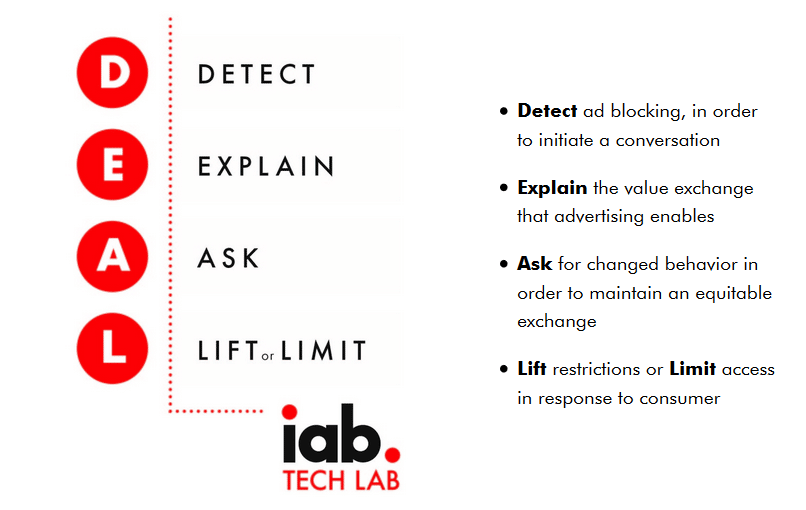
IAB Recommends Publishers Use its DEAL Approach to Manage Ad Blockers
Lorem ipsum dolor sit amet, consectetur adipiscing elit. Ut elit tellus, luctus nec ullamcorper mattis, pulvinar dapibus leo.
Source: IAB

Earlier this week IAB Tech Lab released a primer for publishers on how to handle ad blocking. The 23-page report provides a comprehensive overview of various tactics publishers can use to offset revenue loss caused by ad blocking. While IAB does not recommend a specific tactic, it does recommend an approach it calls DEAL to help publishers communicate with and engage with readers who use ad blocking tools:
Source: IAB

“The conversation about ad blocking continues to evolve, and the norms of expected publisher behavior may change significantly and rapidly. A wide net was cast with regards to risks and benefits, as the group aims to educate about all possibilities,” said the report.
The primer offers seven different tactics that each offer a different level of risk and benefit. Most of the tactics fall in the L (Lift and Limit) section of the recommended DEAL approach.
- Notice: Once ad blocking is detected, the publisher should communicate with the site visitor. This can be done in the page header, on a landing page, a page overlay or in some other way after the visitor has been on the site for a specific period of time. The publisher may choose to use the message to educate the visitor, request that ad blocking software be disabled, ask for donations or micropayments and/or notify the user of what will happen if ad blocking is not disabled or the publisher is not whitelisted. Forbes is using this tactic. When you land on the site, if you’re using an ad blocker or have history tracking turned off in your browser, Forbes will ask you to disable the ad blocker to visit the site.
- Access Denial: Publishers can deny access to content. IAB cautions that this is a drastic move, alienating readers, especially when publishers are testing their tactics or transitioning their ad blocking policy. When access is denied, it is helpful for publishers to educate site visitors on why their access is being revoked and offer options (e.g., micropayments, whitelisting, etc.) to regain access.
- Tiered Experience: With a tiered experience, publishers can provide different levels of access to those who use ad blockers versus subscribers or website visitors who have registered.
- Payments from Visitors: Publishers can ask for payment – donations, micropayments, etc. – in exchange for access to content. GQ is doing this. It asks for site visitors to disable their ad blocker or pay $0.50 per article.
- Ad Reinsertion: Using ad reinsertion technology, ads that bypass ad blocking are reinserted into the content. This can be done by changing ad resource names and URLS, using JavaScript and other code in a browser to generate unblockable requests, and modifying the supply chain so ad resources are delivered by the content server.
- Payment to Ad Blocker Companies: IAB explains that this is a business practice rather than a tactic to address ad blocking.
- Payments to Visitors: Reward visitors for their time spent engaging with advertising (e.g., mobile games that provide extra time or lives, revenue share, etc.) Rezonence’s FreeWall utilizes this tactic, though payments come in the form of free access. A site user reads two paragraphs of an article, and is then presented with an ad and a multiple choice question. Once the reader answers the advertiser’s question, they get to read the remaining article for free.
IAB cautions that these tactics are not appropriate for every publisher and each has its own advantages and disadvantages, benefits and risks. Each publisher must evaluate the impact of ad blocking on its content and advertising revenue and choose the combination of tactics, communication and education it wishes to implement.
Insider Take:
As we’ve said many times, ad blocking is a huge problem. Last year ad blocking cost publishers an estimated $21.8 billion, and in 2016, it will cost them nearly double at $41.4 billion. Some publishers like GQ, Forbes and WIRED are already using ad blocking solutions, while others like The New York Times are experimenting with how to best handle ad blocking.
The bottom line is that consumers do not want their personal history or data tracked, and they do not want intrusive or offensive ads. Publishers, on the other hand, often rely on advertising revenue as a core revenue stream, and they must find a way to satisfy both advertisers and their readers.
Publishers are trying to find that balance, and IAB offers some good information in this primer to help publishers identify the risks and benefits of existing tactics. We like the DEAL approach and the fact that IAB didn’t come out pushing a singular tactic.
We encourage publishers to review the IAB primer as they evaluate how they want to handle ad blocking, and as always, to test their proposed solutions thoroughly before implementing something that could potentially alienate readers and advertisers.





